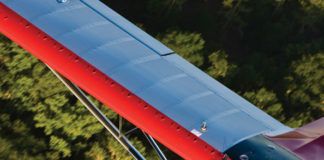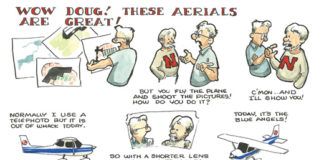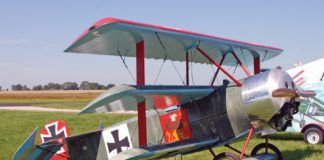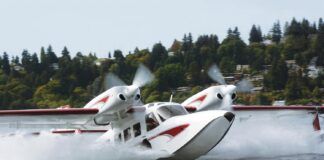Van’s RV-8: Sport Plane Standard Setter
With recent improvements in the kit, did Vans best tandem seat design just get better?
BY ED WISCHMEYER
Photos: Kevin Wing
The RV-8 arguably is the standard sport plane of our era. As we went to press in early July, there were 714 RV-8s flying among the 5200 RVs of all types. The only models with larger fleets among RVs are the -4 and the -6/6A. It trails the -4 by 500 units, but you could easily see the RV-8 making up the gap in its lifetime, especially now that the whole kit is built with pre-punched (or match-hole) components. It has set the standard-in performance and handling-for todays sport planes.
Some 12 years after its debut, how does the RV-8 stack up? And how might it compare to another 8, the mighty F8F Bearcat, found in a hangar facing Dave Klages beautiful subject airplane at Chino, California?
IMGCAP(1)]
Bearcat Dreams
No, I didn’t get to fly the Bearcat, but I did get to sit in the cockpit. Its a long step up to the footwell in the Bearcat fuselage, and a good tug to get up onto the wing. Then its a long step over the side of the fuselage, something that 20year-olds would do much more easily than those of us nearing 60. The cockpit was so tight that my upper arms were firmly up against the canopy rails. The view forward, however, was only barely obstructed by the huge Pratt & Whitney R-2800 Double Wasp engine.
Getting out is more of a challenge, as you cant see the footwell, and back on the ground, I had oil and grease stain souvenirs of my clambering into the cockpit, along with a touch of adrenaline. Its an ugly rumor that an F8F burns more oil per hour than an RV-8 burns gas. But an F8F oil tank holds 40 gallons, while RV-8 fuel tanks hold 42.
The view from the front seat of the RV-8 is not much different from the view of the Bearcat, except its lower. The RV-8 cockpit is roomier, with nearly 2 inches of shoulder room on each side. Although the Bearcat exudes brute force and power, Klages RV-8, with its graceful swooping paint scheme and the rivet heads covered with body filler (a process not officially condoned by Vans Aircraft but seen out in the wild from builders who want extra-special smoothness) looked graceful and lean.
The story of this RV-8 started with Beverly, Klages wife of 47 years. He was an architect who flew a beautiful Cessna 180, but after 16 years of ownership he sold it to put more money into his business. I cried like a baby when I saw it fly away, he says. Then Beverly suggested he try building. Klages flew a number of kit aircraft, but none of them felt right. Then he went to Vans, had a demo ride, and wrote a check on the spot. Two years and some later, his quickbuild RV8 took to the air.
Good Genes
Historically, the first complete kit from Richard VanGrunsven, the RV in RV, was the single-seat RV-3. After a while, the RV-3 crowd wanted to take wives along, and the tandem RV-4 was created. Back then, RV-3 pilots referred to their aircraft as fighters and the RV-4s as bombers. With a tandem airplane, there is a shift in c.g. when a second person is carried, and the RV-4 was set up to handle like the RV-3 when solo, but dual, stick forces were very light. In my old RV-4, for example, the same pull that would give 2 G solo gave 5 G dual.
But then the wives-and others- got tired of riding in the back, so the side-by-side RV-6 came along, and the nosewheel RV-6A arrived to broaden the -6s appeal. But as pilots grew in stature and girth, along came the tandem RV-8, much roomier than the RV4, and because the fuselage was wider at the firewall it lost the distinctive chipmunk cowls of the RV-4. Nevertheless, the -8 was just about as fast for the same power. A nosewheel RV-8A version followed. The RV-8 wings and tail surfaces, with minor modifications, are also used on the side-by-side RV-7/A. That same fuselage is used on the RV-9/A.
All of the short-wing RVs (RV-3 through RV-8) use a NACA 23000 airfoil, 13.5% thick. The -7, -8 and -9 have wings that bolt to a carry-through in the fuselage. On the -3, -4 and -6, the wings have laminated spar caps, and the wing-spars abut in the center of the fuselage. For you purists, the real 23000 has a slight bit of curvature in the aft 25% of the airfoil, where Vans has flat surfaces, and the trailing edge is thicker.
Vans uses the phrase total performance, and its apt. RVs are relatively fast (Vans says 203 mph-176 knots- true at 75% power, 8000 feet, using a 180-horsepower engine), have adequate payload if you don’t squander it on heavy interiors and panel ornaments, 3.4 hours of endurance range with an hours reserve, and the short-wing RVs are great for yank and bank.
Klages RV weighs 1130 pounds empty, and Vans publishes a gross weight of 1800 pounds. For aerobatics, maximum gross weight is 1550 pounds, or 1600 pounds with the later model wings. The c.g. range is from 15% to 29% MAC, but is limited to 25% for aerobatics. In other words, you can do two-seat aerobatics in an RV-8, but not with big guys, full fuel and a heavy airplane. For non-acro flying, Klages airplane has a full-fuel payload of 424 pounds. An advantage the RV-8 has for cross-country flight is baggage compartments front and rear. Because you can put baggage ahead of the c.g., you can fly cross-country without having your c.g. two counties behind you. Believe it or not, the 8 has slightly more cargo volume than the RV-7, according to Vans: 12.4 cubic feed versus 12.0. Still, on the tandem-seater, baggage has to squeeze into two smaller cubbies, so the -7 holds the edge in flexibility.
Klages RV-8 is a beautiful machine, but he points out a rare error. On his canopy, the last hole he drilled generated a crack, now covered by a small American flag. Thats my stupid sticker, he says, as if his gorgeous airplane were anything to be ashamed of. There’s further evidence of a good build: On the ground, the controls are almost frictionless. Klages plane has Vans simple and effective spring aileron trim, and if you know what to look for, you can feel it. When I added it to my RV-4, it made the inevitable minor fuel imbalances on cross-country flights easier to handle, and though it did noticeably degrade the aileron feel, I soon forgot the difference.
Headroom, front and back, is excellent in the RV-8, even with thick seat cushions. I settled into the back seat for the flight out of Chino, at the east end of the Los Angeles basin. Chino is certainly one of the worlds premier big boys toys airports, with everything imaginable on the ramp or in a hangar.
Backseat Boys
As we taxied out with the canopy half open, it was breezy in the back seat. I watched an orange-bellied hawk sit on the PAPI (precision approach path indicator), and observed a ruptured blue helium balloon slowly fluttering down from a clear sky. The canopy came closed for runup, and then we were off .
Klages RV-8 has a 180-hp Lycoming up front with a Hartzell constant-speed propeller. The -7 and -8 are approved for the 200-hp IO-360-and a few have been fitted with the nominally 210-hp IO-390, including Lycomings own RV8-but 180 hp got us moving and levitating in a most satisfactory manner. In the back seat were the optional throttle and rudder pedals. Those rudder pedals are about the size of silver dollars, just right for operating with your big toes. You can move your feet off the pedals into the wheel wells and be off the rudders and still comfortable, but there’s not a lot of wiggle room.
Im a big fan of constant-speed props on RVs, because it is so satisfying to get full power anytime, whether for takeoff , climb or for fighting off induced drag when maneuvering aggressively. Not enough instruments were visible from the back seat to take climb performance measurements, but fleet experience easily validates Vans claims of 1650 fpm at max-gross weight, 1900 fpm with the 200-hp engine.
During climbout, the RV-8 fishtailed in the light turbulence. It was obvious in the back seat, probably noticeable in the front, but not that big a deal for a short flight. An all-day flight in turbulence might be trying in the back for the weak-stomached. But this indicates a significant point about the RV-8-a major part of its mission is to be fun to fly in maneuvering flight, the celebrated yank and bank. If the RV-8 were too stable, it would be less enjoyable to fly. The -8 balances these needs better than most, providing sufficient stability that a glance down at a chart wont result in untoward changes in attitude or altitude. Everything is a compromise; this is a good one.
Yank, Meet Bank
The only appropriate thing to do in a yank-and-bank airplane is to yank and bank. First order of business was a 3-G steep turn, and it was surprisingly easy to do from the back seat, even with obstructed views of the horizon and the instrument panel. I thought the pull on the stick was at the light end of the spectrum for this class of airplane. But to put this in perspective, this was done with two people onboard a tandem-seat aircraft . Although I didn’t get to solo the RV-8, indications are that the stick force and stability are well thought out and a solid compromise between solo and dual flight handling. It wasn’t until after the flight that I realized how much I appreciated having just a touch of pressure to work against in the gentle maneuvers, the 10, 20 and 30 banks. After all, most of the flight time in an RV will be spent, hate to say it, straight and level.
Next on the agenda was a slow build up in G forces to observe the stick force gradient. As we passed 3.5 G, there was a thump, as if we had hit something. Klages said that he seldom went to this G loading, but he had heard the thump once coming out of a loop. After the flight, I talked with Ken Krueger, chief engineer at Vans Aircraft, who said that the thump was probably due to airflow at the root of the flap on the bottom of the fuselage, where an underlapping >piece of skin near the flaps and fuselage could make the noise. In any event, the thump seems to be rare in the fleet and an innocuous phenomenon.
Partial power shows interesting stall characteristics in many planes, so I tried one with 16 inches of manifold pressure. The stall was as you might expect for a sport plane-enough warning for the alert pilot, but not as benign as in, say, a Cessna. Klages plane liked to fall off on the left wing, but there was abundant control authority to make the plane do what you wanted it to, even lift ing the wing with aileron. Throughout all these maneuvers, and I think this is a key to the enthusiastic following that Vans aircraft have, I seemed to have an intuitive feel for what the airplane was doing, was about to do, and what it could be made to do. Granted, I have 350 hours in the similar RV-4, but it was sold six years ago.
VANS RV-8
Price (quickbuild)…………………………………………………….$27,105
Estimated completed price ……………………$40,000 – $100,000
Estimated build time………………………………………….. 1600 hours
Number flying (at press time) …………………………………………714
Powerplant…………………Lycoming O-360, 180 hp @ 2700 rpm
Propeller ………………………………………… Hartzell constant-speed
Powerplant options……………………………………………..160 – 200 hp
Wingspan ………………………………………………………………. 24 ft
Wing loading ……………………………………………….. 15.5 lb/sq ft
Fuel capacity…………………………………………………………..42 gal
Maximum gross weight …………………………………………1800 lb
Typical empty weight…………………………………………….1100 lb
Typical useful load…………………………………………………..700 lb
Full-fuel payload …………………………………………………….454 lb
Seating capacity…………………………………………………………….2
Cabin widTh……………………………………………………………..33 in
Baggage capacity……………………………………………………125 lb
Cruise speed ……………………………………..203 mph (176 kt) TAS
8000 ft @ 75% of max-continuous, 9.5 gph
Maximum rate of climb ……………………………………… 1650 fpm
Stall speed (landing configuration) …………58 mph (50 kt) IAS
Takeoff distance …………………………………………………….. 575 ft
Landing distance…………………………………………………….500 ft
Specifications are manufacturers estimates for the 180-hp version of the RV-8. RV-8A performance is similar. As they say, your mileage may vary.
The RVs use Frise ailerons, hinged so that as the trailing edge of the aileron goes up, the leading edge extends down below the wing to add drag, reducing adverse aileron yaw. With full deflection, which requires putting your shoulder into it, you can get unstable airflow over the aileron and a nibbling at the control stick. Klages airplane showed this phenomenon, hardly a big deal, but he had never observed nor heard of this in his nearly 600 hours in the RV-8.
Another phenomenon seen on some RV-8s, especially those with aftermarket gear legs, is vibration of the horizontal tail during stalls. Id never heard of this occurring with the stock gear legs, but it did on Klages aircraft . Krueger says that the factory is aware of this, but there is sufficient structure in the horizontal tail that it should not be a problem. As Kruegers background includes work on the B-2 and F-22 structures, Im inclined to believe him. There are aftermarket flow fences that fit on the fuselage, just above the wing leading edge and with similar curvature, which are said to resolve the situation. But as Krueger points out, the tail vibration does provide additional stall warning.
Doing stalls with full flaps and 19 inches of power, we saw everything- a ridiculously steep deck angle, a hard thump, tail vibration and falling off on the left wing. But so what? No pilot except a recent refugee from the proverbial clue-free zone should have problems with this.
With the test session completed, we returned to Chino for some landings. A big advantage of the constant-speed prop is that it allows the airplane to decelerate quickly. Add full flaps, and you can fly as steep a pattern as you like. In my old RV-4, slipping with full flaps was routine and easy. A measure of the handling was how easy it was to hold airspeed precisely, within 1 or 2 mph. I used to do that all the time in my RV-4, and Klages airspeed control was equally precise.
For whatever reason, Klages does not get the absolutely swerve-free landings hed like. Maybe it was gear alignment, or maybe it was the tailwheel steering linkage. My hypothesis is that at speeds in the 40-50 mph range, when the rudder is still effective, and if the tailwheel is on the ground, there is a battle of control forces at the tail. If the rudder is deflected enough to get aerodynamic effectiveness, the solid linkage fitted to Klages airplane will deflect the tailwheel too much, whereas the stock springs with some slack in the chains will let you get some rudder deflection with no tailwheel deflection.
In any case, Klages landings were acceptable. Maybe it was because he could accomplish the rest of the flight with such great satisfaction that the minor landing anomalies were discomfiting to him.
Flight Qualities: Another Point of View
Krueger supplied me with a copy of flight-test results performed by the British Popular Flying Association on another builders RV-8. These flights were flown with a variety of c.g. ranges, much more extensive flight-testing than a magazine can perform on a routine basis. That pilot reported neutral pitch stability with a full aft c.g., but no tendency to overcontrol, even with the lighter stick forces. He also reported typically 5 pounds of stick force per G. The same report documented 85 spins at a variety of c.g. locations. That, plus factory static testing of the wings and tail to FAR Part 23 standards, is reassuring.
We didn’t perform any aerobatics, but the PFA report described entry speeds 50-60 knots below Vne, and that 3 G is quite enough to complete most maneuvers. It concluded that, The RV-8 is therefore considered to be suitable for aerobatics by average but properly trained pilots. In more everyday terms, Klages says, I can come out and fly for 10 minutes and change my whole mood and demeanor.
Going back to the battle of the 8s, the RV-8 versus the F8F, I think that having an F8F as your only plane would make about as much sense as having a top fuel dragster as your daily driver- and it is about as likely. For everyday use, when you just want to go out and fly, Id choose the RV-8. Klages put it this way: I think I have more fun flying the RV8 than my friend does flying his Bearcat. And I know I use a hell of a lot less fuel. Maybe that’s an indicator of why it sets the standard for today’s sport planes.
_________________________________________________
For more information, contact Van’s Aircraft at 503/678-6545, or visit the web at http://www.vansaircraft.com/. A direct link can be found at www.kitplanes.com.




